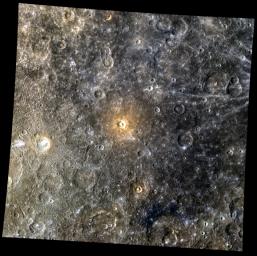At the center of today's image is a "red spot," an informal designation used by the MESSENGER team to refer to an area with overall high reflectance and higher than average reflectance at the longer-wavelength (red) end of the spectrum. Red spots are thought to be sites of explosive (pyroclastic) volcanic eruptions. Such deposits were analyzed in a 2011 paper. A close-up of the crater at the center of the red spot was presented in a previous Gallery image. The crater neat the left edge of the image with bright floor deposits (hollows) is Theophanes.
This image was acquired as part of MDIS's 8-color base map. The 8-color base map is composed of WAC images taken through eight different narrow-band color filters and covers more than 99% of Mercury's surface with an average resolution of 1 kilometer/pixel. The highest-quality color images are obtained for Mercury's surface when both the spacecraft and the Sun are overhead, so these images typically are taken with viewing conditions of low incidence and emission angles.
Date acquired: December 14, 2011
Image Mission Elapsed Time (MET): 232328601, 232328621, 232328605
Image ID: 1134128, 1134133, 1134129
Instrument: Wide Angle Camera (WAC) of the Mercury Dual Imaging System (MDIS)
WAC filters: 9, 7, 6 (996, 748, 433 nanometers) in red, green, and blue
Center Latitude: -3.73°
Center Longitude: 223.8° E
Resolution: 725 meters/pixel
Scale: The scene is about 750 km (465 mi.) wide.
Incidence Angle: 44.7°
Emission Angle: 0.3°
Phase Angle: 44.8°
The MESSENGER spacecraft is the first ever to orbit the planet Mercury, and the spacecraft's seven scientific instruments and radio science investigation are unraveling the history and evolution of the Solar System's innermost planet. MESSENGER acquired over 150,000 images and extensive other data sets. MESSENGER is capable of continuing orbital operations until early 2015.
For information regarding the use of images, see the MESSENGER image use policy.

 Planetary Data System
Planetary Data System












